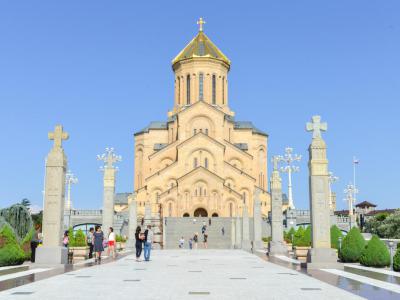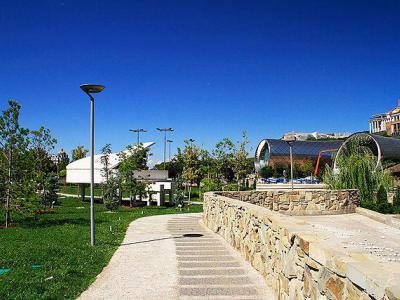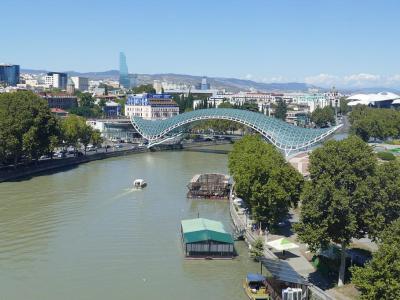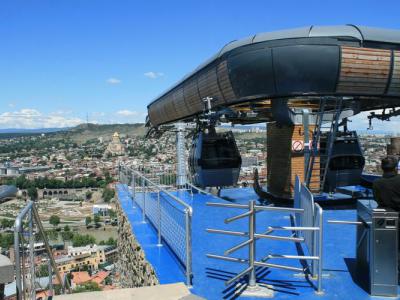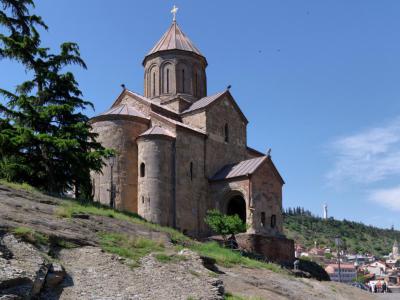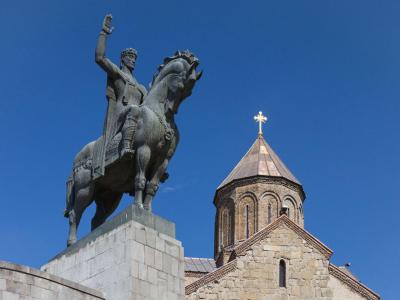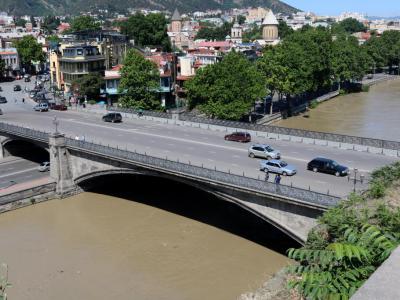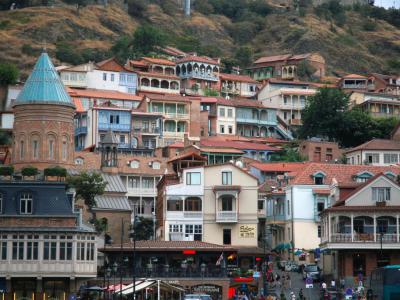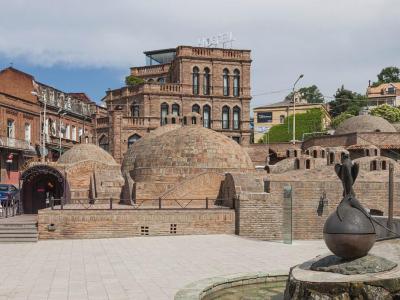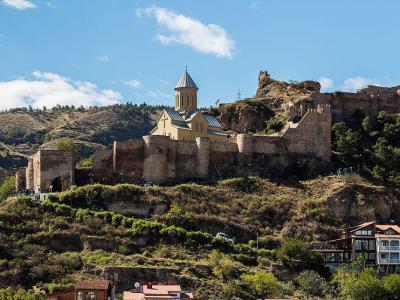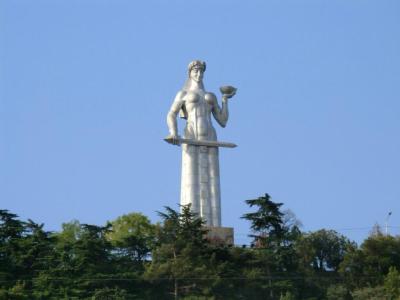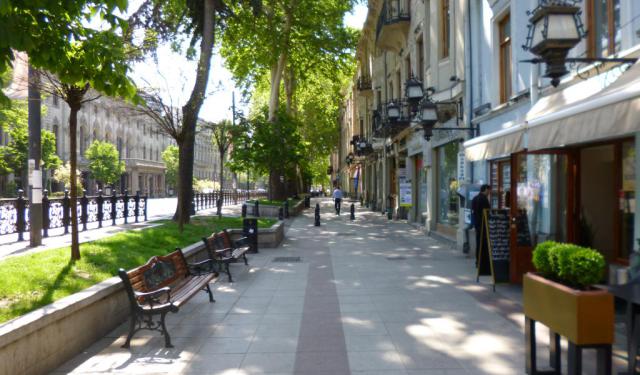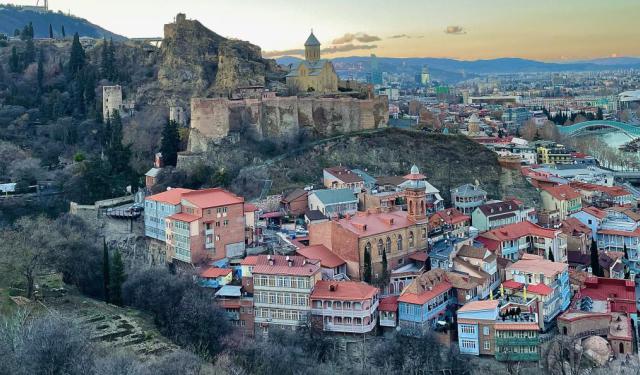
Tbilisi Introduction Walking Tour (Self Guided), Tbilisi
A gateway to Georgia straddling the Mtkvari (Kura) River, the country's capital Tbilisi is one of the most historic cities in the Caucasus region, dating back over a thousand years. It was founded in the 5th century AD by the monarch of Iberia (Georgia's ancient precursor), King Vakhtang I Gorgasali.
According to legend, the king's falcon found the hot springs, near which the city was eventually established, during a hunt. The name "Tbilisi" comes from the Georgian word "tpili," which means warm and reflects the hot sulfur baths that still exist in the historic part of the city called Abanotubani.
The warmth of the legendary hot springs matches the warm hospitality of Tbilisi itself, which is particularly remarkable considering that, over the centuries, the city has been destroyed and rebuilt 29 times following the invasions by Arabs, Mongols, Persians, Turks, and Russians. Tbilisi became the capital of a unified Georgian Kingdom in the 11th century and has since served as the capital of all Georgian states (including as a part of the Russian Empire, Soviet Republic, etc.) until the country regained independence in 1991.
Despite its turbulent history, the city managed to retain its cultural uniqueness and historical charm. A symbol of new Georgia, the golden-domed Holy Trinity Cathedral of Tbilisi (also known as Sameba) is one of the largest Orthodox cathedrals in the world. Another marvelous piece of modern architecture is the bow-shaped pedestrian Bridge of Peace that connects the Old Town with Rike Park over the Mtkvari River. From the park, Tbilisi Cable Car provides a scenic ride to the Narikala Fortress, offering spectacular panoramic views of the capital along the way.
Overlooking the river from an elevated cliff is another landmark, the historic 13th-century Metekhi Church. Nearby you will find the equestrian statue of King Gorgasali paying homage to the legendary founder of the city.
In many ways, Tbilisi is a city of contrasts where ancient culture blends with modern lifestyle, and where East and West "harmonize in perfect melody." Some say that Tbilisi is more than just a city but a feeling that captures your heart and never lets it go, creating an enchantment lingering long after you've left its embrace.
We hereby invite you to explore the cobblestone streets of the Georgian capital and fall in love with its charm. An adventurous spirit will surely be delighted to discover the treasure trove of hidden gems and capture the essence of this amazing city on a self-guided walking tour with GPSmyCity.
According to legend, the king's falcon found the hot springs, near which the city was eventually established, during a hunt. The name "Tbilisi" comes from the Georgian word "tpili," which means warm and reflects the hot sulfur baths that still exist in the historic part of the city called Abanotubani.
The warmth of the legendary hot springs matches the warm hospitality of Tbilisi itself, which is particularly remarkable considering that, over the centuries, the city has been destroyed and rebuilt 29 times following the invasions by Arabs, Mongols, Persians, Turks, and Russians. Tbilisi became the capital of a unified Georgian Kingdom in the 11th century and has since served as the capital of all Georgian states (including as a part of the Russian Empire, Soviet Republic, etc.) until the country regained independence in 1991.
Despite its turbulent history, the city managed to retain its cultural uniqueness and historical charm. A symbol of new Georgia, the golden-domed Holy Trinity Cathedral of Tbilisi (also known as Sameba) is one of the largest Orthodox cathedrals in the world. Another marvelous piece of modern architecture is the bow-shaped pedestrian Bridge of Peace that connects the Old Town with Rike Park over the Mtkvari River. From the park, Tbilisi Cable Car provides a scenic ride to the Narikala Fortress, offering spectacular panoramic views of the capital along the way.
Overlooking the river from an elevated cliff is another landmark, the historic 13th-century Metekhi Church. Nearby you will find the equestrian statue of King Gorgasali paying homage to the legendary founder of the city.
In many ways, Tbilisi is a city of contrasts where ancient culture blends with modern lifestyle, and where East and West "harmonize in perfect melody." Some say that Tbilisi is more than just a city but a feeling that captures your heart and never lets it go, creating an enchantment lingering long after you've left its embrace.
We hereby invite you to explore the cobblestone streets of the Georgian capital and fall in love with its charm. An adventurous spirit will surely be delighted to discover the treasure trove of hidden gems and capture the essence of this amazing city on a self-guided walking tour with GPSmyCity.
How it works: Download the app "GPSmyCity: Walks in 1K+ Cities" from Apple App Store or Google Play Store to your mobile phone or tablet. The app turns your mobile device into a personal tour guide and its built-in GPS navigation functions guide you from one tour stop to next. The app works offline, so no data plan is needed when traveling abroad.
Tbilisi Introduction Walking Tour Map
Guide Name: Tbilisi Introduction Walking Tour
Guide Location: Georgia » Tbilisi (See other walking tours in Tbilisi)
Guide Type: Self-guided Walking Tour (Sightseeing)
# of Attractions: 11
Tour Duration: 2 Hour(s)
Travel Distance: 3.8 Km or 2.4 Miles
Author: nataly
Sight(s) Featured in This Guide:
Guide Location: Georgia » Tbilisi (See other walking tours in Tbilisi)
Guide Type: Self-guided Walking Tour (Sightseeing)
# of Attractions: 11
Tour Duration: 2 Hour(s)
Travel Distance: 3.8 Km or 2.4 Miles
Author: nataly
Sight(s) Featured in This Guide:
- Holy Trinity Cathedral of Tbilisi
- Rike Park
- Bridge of Peace
- Tbilisi Cable Car
- Metekhi Church
- Monument of King Vakhtang Gorgasali
- Metekhi Bridge
- Meidan Square
- Abanotubani
- Narikala Fortress
- Kartlis Deda (Mother of Georgia)
1) Holy Trinity Cathedral of Tbilisi (must see)
Holy Trinity Cathedral of Tbilisi, commonly known as Sameba, stands proudly as the primary cathedral of the Georgian Orthodox Church in Tbilisi. From 1995 to 2004, this magnificent structure was meticulously built, becoming the third-tallest Eastern Orthodox cathedral worldwide and one of the largest religious edifices in terms of total area. Sameba embodies a harmonious blend of traditional styles that have prevailed in Georgian church architecture throughout different periods, with subtle echoes of Byzantine influence.
In 1989, the idea of building a new cathedral to commemorate the autocephaly of the Georgian Orthodox Church and the birth of Jesus emerged. An international contest was announced in May 1989, and architect Archil Mindiashvili's design won. Due to civil unrest, the plan was delayed for six years until November 1995 when the foundation was laid. On November 23, 2004, the cathedral was consecrated. The chosen site included an old Armenian cemetery called Khojavank, which had been destroyed during the Soviet period.
Holy Trinity Cathedral is located on Elia Hill in Avlabari, Old Tbilisi, overlooking the Kura River. It features a traditional Georgian design with a vertical emphasis. The cathedral has a cruciform plan with a dome supported by eight columns. The dome is topped with a 7.5-meter-tall gold cross. The cathedral includes nine chapels, with five underground. It covers an area of 3,000 square meters. The construction uses natural materials, and the murals are painted by a group of artists led by Amiran Goglidze. The cathedral complex also includes a bell tower, the Patriarch's residence, a monastery, a seminary, an academy, workshops, and rest areas.
In 1989, the idea of building a new cathedral to commemorate the autocephaly of the Georgian Orthodox Church and the birth of Jesus emerged. An international contest was announced in May 1989, and architect Archil Mindiashvili's design won. Due to civil unrest, the plan was delayed for six years until November 1995 when the foundation was laid. On November 23, 2004, the cathedral was consecrated. The chosen site included an old Armenian cemetery called Khojavank, which had been destroyed during the Soviet period.
Holy Trinity Cathedral is located on Elia Hill in Avlabari, Old Tbilisi, overlooking the Kura River. It features a traditional Georgian design with a vertical emphasis. The cathedral has a cruciform plan with a dome supported by eight columns. The dome is topped with a 7.5-meter-tall gold cross. The cathedral includes nine chapels, with five underground. It covers an area of 3,000 square meters. The construction uses natural materials, and the murals are painted by a group of artists led by Amiran Goglidze. The cathedral complex also includes a bell tower, the Patriarch's residence, a monastery, a seminary, an academy, workshops, and rest areas.
2) Rike Park
Rike Park, on the right bank of the Kura River, is across from Tbilisi's Old Town. Established in 2010, it's now a popular starting point for tourist routes and has a cable car station to the Narikala Fortress. Originally a sandy island, the river changed course, creating a lowland called Rike. The name "Rike," derived from the Georgian language, translates to "Sands." In 2010, the lowland area was fortified, and Rike Park was established.
Rike Park, an artistic symbol of revitalized Georgia, initially faced skepticism like the Eiffel Tower in Paris. Despite doubts, it became an integral part of the city's identity. The park features traditional elements like trees, flowers, and art, alongside modern additions like unique metal structures and the impressive Bridge of Peace connecting it to the Old Town.
The park boasts numerous playgrounds featuring a gentle surface, intertwined with mazes of lush greenery. A rock climbing structure and a grand Chess platform with meter-sized pieces add to the park's allure. Alongside these attractions, various artistic installations grace the landscape, including a majestic grand piano and a cubism-inspired drinking fountain. During the summer months, the park delights visitors with nightly performances of singing and dancing fountains.
The park's attractions are beautifully lit, and there are many restaurants nearby. Plus, the Old Town's landmarks are close by. Adjacent to Europe Square is the cable car Lower Station, providing easy access to Narikala Fortress and the Mother-Georgia Monument.
Rike Park, an artistic symbol of revitalized Georgia, initially faced skepticism like the Eiffel Tower in Paris. Despite doubts, it became an integral part of the city's identity. The park features traditional elements like trees, flowers, and art, alongside modern additions like unique metal structures and the impressive Bridge of Peace connecting it to the Old Town.
The park boasts numerous playgrounds featuring a gentle surface, intertwined with mazes of lush greenery. A rock climbing structure and a grand Chess platform with meter-sized pieces add to the park's allure. Alongside these attractions, various artistic installations grace the landscape, including a majestic grand piano and a cubism-inspired drinking fountain. During the summer months, the park delights visitors with nightly performances of singing and dancing fountains.
The park's attractions are beautifully lit, and there are many restaurants nearby. Plus, the Old Town's landmarks are close by. Adjacent to Europe Square is the cable car Lower Station, providing easy access to Narikala Fortress and the Mother-Georgia Monument.
3) Bridge of Peace (must see)
The Bridge of Peace is an arched pedestrian bridge located in Tbilisi. It is made of steel and glass and is adorned with numerous LEDs, which create an illuminating effect. The bridge spans the Kura River and connects Rike Park to the Old Town.
Tbilisi City Hall built a 150-meter bridge (490 ft) to connect the old and new districts. It opened on May 6, 2010, providing scenic views of the Kura River, Metekhi Church, Vakhtang Gorgasali statue, and Narikala Fortress on one side. On the other side, you can see Baratashvili Bridge and the Ceremonial Palace of Georgia.
The bridge's design was conceptualized by Michele De Lucchi, an Italian architect who also designed the Ceremonial Palace of Georgia and the Ministry of Internal Affairs buildings in Tbilisi. The lighting design was crafted by Philippe Martinaud, a renowned French lighting designer.
The bridge's unique design resembles that of a marine creature. It features a curvaceous steel and glass canopy that sparkles with an interactive light display at night, thanks to thousands of white LEDs. The roof is equipped with 1,208 custom LED fixtures. The glass panels along the handrail, which extend throughout the entire length of the walkway, contain embedded linear low-power LED arrays.
Since its inauguration in 2010, the bridge has become a vital crossing for pedestrians, a popular tourist attraction, and an iconic symbol of the capital.
Tbilisi City Hall built a 150-meter bridge (490 ft) to connect the old and new districts. It opened on May 6, 2010, providing scenic views of the Kura River, Metekhi Church, Vakhtang Gorgasali statue, and Narikala Fortress on one side. On the other side, you can see Baratashvili Bridge and the Ceremonial Palace of Georgia.
The bridge's design was conceptualized by Michele De Lucchi, an Italian architect who also designed the Ceremonial Palace of Georgia and the Ministry of Internal Affairs buildings in Tbilisi. The lighting design was crafted by Philippe Martinaud, a renowned French lighting designer.
The bridge's unique design resembles that of a marine creature. It features a curvaceous steel and glass canopy that sparkles with an interactive light display at night, thanks to thousands of white LEDs. The roof is equipped with 1,208 custom LED fixtures. The glass panels along the handrail, which extend throughout the entire length of the walkway, contain embedded linear low-power LED arrays.
Since its inauguration in 2010, the bridge has become a vital crossing for pedestrians, a popular tourist attraction, and an iconic symbol of the capital.
4) Tbilisi Cable Car (must see)
The Tbilisi Cable Car is a convenient and scenic mode of transportation that connects Rike Park, specifically Europe Square, to the historic fortress of Narikala. This aerial tramway provides visitors with a unique and enjoyable way to reach the fortress while offering breathtaking views of the city.
The Tbilisi Cable Car, opened in 2012, offers a lovely and enjoyable experience for tourists and locals alike. It provides a convenient option for those looking for an efficient way to reach the Narikala Fortress. The aerial tramway allows you to bypass the steep climbs and instead enjoy a relaxed ascent to the fortress while marveling at the panoramic views of the city below.
Once you reach Narikala, you can begin your exploration of Tbilisi from this elevated vantage point. The fortress itself is a fascinating historical site with centuries of history and offers stunning views of the city and the Mtkvari River. From there, you have the option to embark on mountainous hikes, allowing you to further immerse yourself in the natural beauty of the surrounding landscape.
The Tbilisi Cable Car is not only a practical means of transportation but also a delightful way to experience the beauty of Tbilisi from above. Whether you're visiting the Narikala fortress or simply looking for a memorable journey through the city, the cable car provides a unique perspective and should be considered as part of your Tbilisi itinerary.
The Tbilisi Cable Car, opened in 2012, offers a lovely and enjoyable experience for tourists and locals alike. It provides a convenient option for those looking for an efficient way to reach the Narikala Fortress. The aerial tramway allows you to bypass the steep climbs and instead enjoy a relaxed ascent to the fortress while marveling at the panoramic views of the city below.
Once you reach Narikala, you can begin your exploration of Tbilisi from this elevated vantage point. The fortress itself is a fascinating historical site with centuries of history and offers stunning views of the city and the Mtkvari River. From there, you have the option to embark on mountainous hikes, allowing you to further immerse yourself in the natural beauty of the surrounding landscape.
The Tbilisi Cable Car is not only a practical means of transportation but also a delightful way to experience the beauty of Tbilisi from above. Whether you're visiting the Narikala fortress or simply looking for a memorable journey through the city, the cable car provides a unique perspective and should be considered as part of your Tbilisi itinerary.
5) Metekhi Church
The Metekhi Church, officially known as the Virgin Mary Assumption Church of Metekhi, is a remarkable Georgian Orthodox Christian church that stands proudly on the left bank of the river Kura in Tbilisi. Situated on the picturesque Metekhi Cliff, it gazes across the flowing waters toward the old town. This historical gem bears witness to centuries of Georgian culture and religious devotion.
The Metekhi Church has medieval origins, dating between 1278 and 1289 AD. It started taking shape under King Demetrius II of Georgia. According to oral tradition, its roots go back to the 5th century. Following Georgian tradition, the church seamlessly blends with the cliff it stands on, creating the illusion of a natural extension of the rocky precipice. Its unique design enhances its allure and emphasizes the connection between spirituality and nature.
The church is a cross-in-square design, covering an area of approximately 20 × 16 meters. It features a vertical elongation, emphasizing its verticality and commanding presence. The eastern facade is adorned with three convex apses, with the central apse being the largest. This distinctive architectural feature sets Metekhi Church apart from other churches built during the 11th to 13th centuries and adds to its allure.
Inside, the church's dome is supported by four archaic pillars, predating the popular two-pillar design. Semicircular projections on the pillars highlight its historical significance. Despite renovations, these ancient elements were preserved, offering visitors a glimpse into the past and enriching the church's history.
The Metekhi Church has medieval origins, dating between 1278 and 1289 AD. It started taking shape under King Demetrius II of Georgia. According to oral tradition, its roots go back to the 5th century. Following Georgian tradition, the church seamlessly blends with the cliff it stands on, creating the illusion of a natural extension of the rocky precipice. Its unique design enhances its allure and emphasizes the connection between spirituality and nature.
The church is a cross-in-square design, covering an area of approximately 20 × 16 meters. It features a vertical elongation, emphasizing its verticality and commanding presence. The eastern facade is adorned with three convex apses, with the central apse being the largest. This distinctive architectural feature sets Metekhi Church apart from other churches built during the 11th to 13th centuries and adds to its allure.
Inside, the church's dome is supported by four archaic pillars, predating the popular two-pillar design. Semicircular projections on the pillars highlight its historical significance. Despite renovations, these ancient elements were preserved, offering visitors a glimpse into the past and enriching the church's history.
6) Monument of King Vakhtang Gorgasali
The Monument of King Vakhtang Gorgasali is an iconic landmark situated in Tbilisi. This magnificent statue pays tribute to King Vakhtang Gorgasali, one of the most revered figures in Georgian history and the founder of Tbilisi.
The monument, created by Georgian sculptor Elguja Amashukeli, is located on the picturesque Sololaki Hill, overlooking the old town of Tbilisi and the Kura River. It stands as a symbol of the city's rich historical and cultural heritage. Erected in 1967, the statue is an imposing bronze sculpture that depicts King Vakhtang Gorgasali on horseback.
King Vakhtang Gorgasali, who ruled in the 5th century AD, played a pivotal role in the development and expansion of Tbilisi. Legend has it that during a hunting trip, the king's falcon caught a pheasant and both birds fell into a natural hot spring. Impressed by the healing properties of the hot spring, King Vakhtang decided to establish a city in that location, which later became Tbilisi.
The monument not only serves as a commemoration of King Vakhtang Gorgasali but also represents the strength, resilience, and unity of the Georgian people. It has become an important symbol of national identity and a significant attraction for tourists visiting Tbilisi.
Surrounding the monument, there is a small park area with benches, providing a tranquil space for locals and visitors to relax and enjoy the breathtaking views of the city. The site is often frequented by tourists who are drawn to its historical significance and the stunning panorama it offers.
The monument, created by Georgian sculptor Elguja Amashukeli, is located on the picturesque Sololaki Hill, overlooking the old town of Tbilisi and the Kura River. It stands as a symbol of the city's rich historical and cultural heritage. Erected in 1967, the statue is an imposing bronze sculpture that depicts King Vakhtang Gorgasali on horseback.
King Vakhtang Gorgasali, who ruled in the 5th century AD, played a pivotal role in the development and expansion of Tbilisi. Legend has it that during a hunting trip, the king's falcon caught a pheasant and both birds fell into a natural hot spring. Impressed by the healing properties of the hot spring, King Vakhtang decided to establish a city in that location, which later became Tbilisi.
The monument not only serves as a commemoration of King Vakhtang Gorgasali but also represents the strength, resilience, and unity of the Georgian people. It has become an important symbol of national identity and a significant attraction for tourists visiting Tbilisi.
Surrounding the monument, there is a small park area with benches, providing a tranquil space for locals and visitors to relax and enjoy the breathtaking views of the city. The site is often frequented by tourists who are drawn to its historical significance and the stunning panorama it offers.
7) Metekhi Bridge
Metekhi Bridge, located in the old part of Tbilisi, is a historic bridge named after One hundred thousand Georgian martyrs. Situated on the river Mtkvari, near the Metekhi temple, the bridge offers a stunning view of the city and is considered one of the most popular attractions in Tbilisi.
Metekhi Bridge has a rich history spanning many centuries. In the early Middle Ages, a bridge stood at this location, strategically positioned under the watchful eyes of fortifications on both sides of the river. This allowed for effective control of the riverbed and the road that ran alongside it. It is believed that the bridge may have also held religious significance.
Over the years, the bridge has been demolished and rebuilt multiple times. Historical accounts suggest that an initial one-story wooden bridge existed in the early days. In 1046, when Bagrat IV entered Tbilisi, the bridge was destroyed by the people of Isani. It was reconstructed in 1797 but was swept away by a flood in 1805. Another bridge was built in its place, featuring arches, which stood until 1826. In 1870, a metal bridge was erected, preceding the current Metekhi Bridge that was opened in 1951.
The area around Metekhi Bridge is bustling with various cafes, restaurants, and hotels, providing opportunities to savor the delicious flavors of Georgian cuisine and enjoy a pleasant time. The bridge's proximity to cultural and historical monuments, coupled with its beautiful surroundings and breathtaking views, make it a popular destination for both locals and tourists.
Metekhi Bridge has a rich history spanning many centuries. In the early Middle Ages, a bridge stood at this location, strategically positioned under the watchful eyes of fortifications on both sides of the river. This allowed for effective control of the riverbed and the road that ran alongside it. It is believed that the bridge may have also held religious significance.
Over the years, the bridge has been demolished and rebuilt multiple times. Historical accounts suggest that an initial one-story wooden bridge existed in the early days. In 1046, when Bagrat IV entered Tbilisi, the bridge was destroyed by the people of Isani. It was reconstructed in 1797 but was swept away by a flood in 1805. Another bridge was built in its place, featuring arches, which stood until 1826. In 1870, a metal bridge was erected, preceding the current Metekhi Bridge that was opened in 1951.
The area around Metekhi Bridge is bustling with various cafes, restaurants, and hotels, providing opportunities to savor the delicious flavors of Georgian cuisine and enjoy a pleasant time. The bridge's proximity to cultural and historical monuments, coupled with its beautiful surroundings and breathtaking views, make it a popular destination for both locals and tourists.
8) Meidan Square
Meidan Square, located in the heart of Old Tbilisi, is undoubtedly one of the most popular and vibrant places to visit in the city. Steeped in history and adorned with unique architectural wonders, Meidan offers a delightful blend of cultural, historical, and natural attractions.
Meidan Square, also referred to as Meidan Bazaar or Meidan Place, served as a bustling commercial hub, attracting traders from medieval times until the 18th century. Situated within the Old City, it retains its significance as a vital part of the area's heritage.
As you step into Meidan Square, you'll immediately be captivated by its characteristic architecture, reflecting the rich cultural heritage of Georgia. The square is home to a myriad of noteworthy landmarks and sights that are worth exploring. Here you will find the Sulfur Baths, the Mosque decorated with a blue mosaic and Leghvtakhevi Waterfall.
Meidan Square is not only a historical and cultural hub but also a vibrant social center. The square is adorned with numerous cafes and restaurants, offering a wide array of culinary delights for visitors to savor. From traditional Georgian dishes to international cuisines, Meidan provides a perfect gastronomic experience amidst its charming surroundings.
Exploring Meidan Square wouldn't be complete without indulging in some shopping. The square is lined with shops that showcase Georgian motifs, local beverages, carpets, and antiques. Here, you can browse through an array of unique and interesting items, providing an opportunity to take a piece of Georgian culture and craftsmanship back home.
Meidan Square, also referred to as Meidan Bazaar or Meidan Place, served as a bustling commercial hub, attracting traders from medieval times until the 18th century. Situated within the Old City, it retains its significance as a vital part of the area's heritage.
As you step into Meidan Square, you'll immediately be captivated by its characteristic architecture, reflecting the rich cultural heritage of Georgia. The square is home to a myriad of noteworthy landmarks and sights that are worth exploring. Here you will find the Sulfur Baths, the Mosque decorated with a blue mosaic and Leghvtakhevi Waterfall.
Meidan Square is not only a historical and cultural hub but also a vibrant social center. The square is adorned with numerous cafes and restaurants, offering a wide array of culinary delights for visitors to savor. From traditional Georgian dishes to international cuisines, Meidan provides a perfect gastronomic experience amidst its charming surroundings.
Exploring Meidan Square wouldn't be complete without indulging in some shopping. The square is lined with shops that showcase Georgian motifs, local beverages, carpets, and antiques. Here, you can browse through an array of unique and interesting items, providing an opportunity to take a piece of Georgian culture and craftsmanship back home.
9) Abanotubani
Abanotubani is a neighborhood in Tbilisi renowned for its public sulfur baths and breathtaking views. Abanotubani offers a captivating experience that captures the essence of Tbilisi. Visitors can explore the charm of the city and encounter a myriad of religious and historical buildings nestled within its compact boundaries.
Abanotubani showcases a rich tapestry of diverse religious structures, reflecting the multicultural heritage of Tbilisi. Within this small neighborhood, visitors can encounter Georgian, Armenian, and Catholic churches, as well as mosques. This harmonious coexistence of different faiths adds to the unique character of Abanotubani and highlights the city's long history of religious tolerance.
The distinctive feature of Abanotubani lies in its brick domes that rise above the surface, marking the presence of underground thermal baths. These baths have a long-standing tradition in Tbilisi, as the city is renowned for its sulfur-rich mineral waters.
Adding to the allure of Abanotubani are the facades adorned with ornate blue tiles. These intricate designs, often featuring geometric patterns or floral motifs, contribute to the aesthetic appeal of the neighborhood. The blue tiles are a hallmark of Georgian architecture and lend a distinct charm to the buildings in Abanotubani.
In addition to its architectural and scenic beauty, Abanotubani is a hub of activity. The neighborhood is home to numerous cafes, restaurants, and art galleries, providing visitors with ample opportunities to immerse themselves in the local culture. Exploring the narrow streets, one can discover hidden gems, artisan shops, and vibrant street art, adding to the vibrant atmosphere of Abanotubani.
Abanotubani showcases a rich tapestry of diverse religious structures, reflecting the multicultural heritage of Tbilisi. Within this small neighborhood, visitors can encounter Georgian, Armenian, and Catholic churches, as well as mosques. This harmonious coexistence of different faiths adds to the unique character of Abanotubani and highlights the city's long history of religious tolerance.
The distinctive feature of Abanotubani lies in its brick domes that rise above the surface, marking the presence of underground thermal baths. These baths have a long-standing tradition in Tbilisi, as the city is renowned for its sulfur-rich mineral waters.
Adding to the allure of Abanotubani are the facades adorned with ornate blue tiles. These intricate designs, often featuring geometric patterns or floral motifs, contribute to the aesthetic appeal of the neighborhood. The blue tiles are a hallmark of Georgian architecture and lend a distinct charm to the buildings in Abanotubani.
In addition to its architectural and scenic beauty, Abanotubani is a hub of activity. The neighborhood is home to numerous cafes, restaurants, and art galleries, providing visitors with ample opportunities to immerse themselves in the local culture. Exploring the narrow streets, one can discover hidden gems, artisan shops, and vibrant street art, adding to the vibrant atmosphere of Abanotubani.
10) Narikala Fortress (must see)
Narikala Fortress, perched on a steep hill overlooking the picturesque city of Tbilisi and the flowing Mtkvari River, stands as a testament to Georgia's rich history and architectural heritage. This ancient fortress, consisting of two walled sections, is situated between the renowned Sulfur Baths and the enchanting Botanical Gardens of Tbilisi.
The Narikala Fortress has a rich history. It was constructed by King Vakhtang I Gorgasali of Iberia, but humans settled in the Tbilisi region long before that, around the 4th millennium BC. The earliest written records of the settlement date back to the 4th century AD when King Varaz-Bakur built a fortress in 364. It changed hands briefly but was recaptured in the 5th century. The fortress expanded under the Umayyads in the 7th century and during King David the Builder's reign (1089-1125). The Mongols later renamed it "Narin Qala." Most of the fortifications we see today were built in the 16th and 17th centuries. Sadly, an earthquake in 1827 damaged and demolished parts of the fortress.
Within the lower court of Narikala Fortress, visitors can marvel at the recently restored St. Nicholas Church. This church, built in 1996-1997, is a reconstruction of the original 13th-century church that had tragically succumbed to a devastating fire. The new St. Nicholas Church follows the design of a "prescribed cross" featuring entrances on three sides. Its interior is adorned with intricately painted frescoes, depicting scenes from both the Bible and the captivating history of Georgia.
Today, Narikala Fortress stands as an iconic symbol of Tbilisi, offering visitors breathtaking panoramic views of the cityscape and the Mtkvari River. Exploring its ancient walls and the restored St. Nicholas Church is a journey through time, allowing visitors to immerse themselves in the history, culture, and architectural splendor of Georgia's capital city.
The Narikala Fortress has a rich history. It was constructed by King Vakhtang I Gorgasali of Iberia, but humans settled in the Tbilisi region long before that, around the 4th millennium BC. The earliest written records of the settlement date back to the 4th century AD when King Varaz-Bakur built a fortress in 364. It changed hands briefly but was recaptured in the 5th century. The fortress expanded under the Umayyads in the 7th century and during King David the Builder's reign (1089-1125). The Mongols later renamed it "Narin Qala." Most of the fortifications we see today were built in the 16th and 17th centuries. Sadly, an earthquake in 1827 damaged and demolished parts of the fortress.
Within the lower court of Narikala Fortress, visitors can marvel at the recently restored St. Nicholas Church. This church, built in 1996-1997, is a reconstruction of the original 13th-century church that had tragically succumbed to a devastating fire. The new St. Nicholas Church follows the design of a "prescribed cross" featuring entrances on three sides. Its interior is adorned with intricately painted frescoes, depicting scenes from both the Bible and the captivating history of Georgia.
Today, Narikala Fortress stands as an iconic symbol of Tbilisi, offering visitors breathtaking panoramic views of the cityscape and the Mtkvari River. Exploring its ancient walls and the restored St. Nicholas Church is a journey through time, allowing visitors to immerse themselves in the history, culture, and architectural splendor of Georgia's capital city.
11) Kartlis Deda (Mother of Georgia)
Mother of Georgia (Kartvlis Deda), a monument located in Tbilisi, stands proudly atop Sololaki Hill. Constructed in 1958, during Tbilisi's 1500th-anniversary celebration, the monument was designed by the renowned Georgian sculptor Elguja Amashukeli. Depicting a twenty-meter-tall woman adorned in traditional Georgian attire, the statue serves as a symbol of the Georgian national character.
Mother of Georgia holds significant meaning, with her left hand presenting a bowl of wine to warmly welcome friendly visitors, while her right-hand brandishes a sword, ready to face any potential enemies. This representation embodies the history of Tbilisi, showcasing the city's historical battles against adversaries and its tradition of embracing amicable guests.
Elguja Amashukeli's exceptional work on the sculpture earned him the prestigious Shota Rustaveli State Prize in 1966. Initially referred to as "Capital" by the sculptor, the statue came to be commonly known as the "Mother of Georgia." Originally crafted as a temporary wooden allegorical statue in 1958, it transformed in 1963 when it was coated with aluminum to protect it from environmental damage. In 1997, the original statue was replaced with a new one, ensuring the enduring presence of this iconic monument.
Mother of Georgia holds significant meaning, with her left hand presenting a bowl of wine to warmly welcome friendly visitors, while her right-hand brandishes a sword, ready to face any potential enemies. This representation embodies the history of Tbilisi, showcasing the city's historical battles against adversaries and its tradition of embracing amicable guests.
Elguja Amashukeli's exceptional work on the sculpture earned him the prestigious Shota Rustaveli State Prize in 1966. Initially referred to as "Capital" by the sculptor, the statue came to be commonly known as the "Mother of Georgia." Originally crafted as a temporary wooden allegorical statue in 1958, it transformed in 1963 when it was coated with aluminum to protect it from environmental damage. In 1997, the original statue was replaced with a new one, ensuring the enduring presence of this iconic monument.
Walking Tours in Tbilisi, Georgia
Create Your Own Walk in Tbilisi
Creating your own self-guided walk in Tbilisi is easy and fun. Choose the city attractions that you want to see and a walk route map will be created just for you. You can even set your hotel as the start point of the walk.
Rustaveli Avenue Walking Tour
If Tbilisi is the heart of Georgia, then Rustaveli Avenue is its pulse. As the capital's main artery, the importance – historical, cultural, or architectural – of this vibrant and bustling thoroughfare is hard to overestimate.
Named after the renowned medieval Georgian poet Shota Rustaveli, the avenue starts from Freedom Square – a key downtown landmark, home to the iconic statue of... view more
Tour Duration: 2 Hour(s)
Travel Distance: 2.5 Km or 1.6 Miles
Named after the renowned medieval Georgian poet Shota Rustaveli, the avenue starts from Freedom Square – a key downtown landmark, home to the iconic statue of... view more
Tour Duration: 2 Hour(s)
Travel Distance: 2.5 Km or 1.6 Miles
The Most Popular Cities
/ view all
